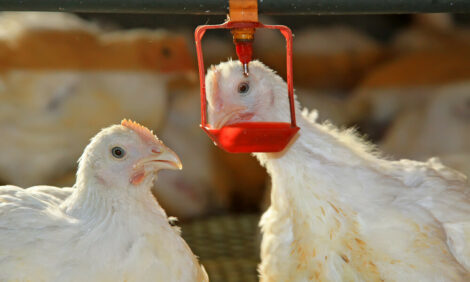



Poultry Farming Turns Lucrative Alternative in Tamil Nadu
INDIA - The Tamil Nadu State government’s ambitious plan to popularise poultry farming, with 50 per cent subsidy, in the non-traditional areas of the State has started yielding dividends.An extensive tour of the interior parts of Karur district recently, which borders with Namakkal and Coimbatore districts on western and northern side that are known for broiler farms, showed that poultry farming was set to become a premier occupation of farmers in the rain shadow region of the State.
As per the plan, if a progressive farmer comes forward to set up a poultry unit for rearing 5,000 birds, the government will provide 50 per cent subsidy, of which 25 per cent will be borne by the National Bank for Agricultural and Rural Development (NABARD). Besides helping and guiding farmers to avail bank loan to the tune of Rs. 8.25 lakh (total cost of the project), the Department of Animal Husbandry will provide technical assistance to set up the unit. Farmers can go for lesser number of birds.
Less than two years of the launch of the scheme, more than 50 poultry units have sprung up in different parts of Karur district, mostly in K. Paramathi. Several of them have cleared the first batch of chicks, and are preparing for second batch. Some of the beneficiaries had already gained sufficient knowledge on broiler farming thanks to the training provided by the University Training and Research Centre, Karur, a peripheral unit of Tamil Nadu Veterinary and Animal Sciences University.
M. Thangaraj, Joint Director, Department of Animal Husbandry, Karur, told The Hindu that the Poultry Development Scheme had taken off to a good start. The response was excellent.
The initial results showed that poultry farming would get the imagination of entrepreneurs of the region, who wanted to take up new initiatives boldly.
N. Kulandasamy, Assistant Director, said that many of the 103 beneficiaries, who had been given training and obtained the provisional sanction from banks, had set up modernised poultry units. The sheds continued to get visitors from the neighbouring villages.
They had entered into buy back arrangements with leading private companies, who supplied all raw material, including chicks, equipment, feed, medicine, and vaccines. Besides ensuring correct temperature in the shed, the entrepreneurs had just to provide feed to the chicks for 40 days.
“I feel happy to say that I am a proud owner of poultry unit. It promises a good return to the investment. The 50 per cent subsidy is a boon to the rural poor farmer to start poultry unit,” says V. Maheswari, a progressive farmer in Pallamarudhu Patty in K. Paramathi block. Her husband Velusamy hoped that if the birds were raised as per the standard, a farmer could get a revenue of around Rs. 80,000 per batch (40 days) for raising 5,000 birds.
G. Mohanraj, K.B. Tamilarasan, and S. Senthilmuthu Kumaran, veterinarians, who offered technical advice to the beneficiaries, said that poultry had possessed one of the most profitable live stock enterprises in the State.











